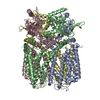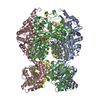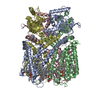+ Open data
Open data
- Basic information
Basic information
| Entry | Database: PDB / ID: 7rhs | |||||||||||||||||||||
|---|---|---|---|---|---|---|---|---|---|---|---|---|---|---|---|---|---|---|---|---|---|---|
| Title | Cryo-EM structure of apo-state of human CNGA3/CNGB3 channel | |||||||||||||||||||||
 Components Components |
| |||||||||||||||||||||
 Keywords Keywords | TRANSPORT PROTEIN / cone / CNG channel / cGMP | |||||||||||||||||||||
| Function / homology |  Function and homology information Function and homology informationinorganic cation import across plasma membrane / intracellular cyclic nucleotide activated cation channel complex / intracellularly cGMP-activated cation channel activity / intracellularly cAMP-activated cation channel activity / transmembrane transporter complex / axon initial segment / ligand-gated monoatomic ion channel activity / myosin binding / sodium channel activity / monoatomic cation transmembrane transport ...inorganic cation import across plasma membrane / intracellular cyclic nucleotide activated cation channel complex / intracellularly cGMP-activated cation channel activity / intracellularly cAMP-activated cation channel activity / transmembrane transporter complex / axon initial segment / ligand-gated monoatomic ion channel activity / myosin binding / sodium channel activity / monoatomic cation transmembrane transport / cGMP binding / response to magnesium ion / glial cell projection / monoatomic cation transport / photoreceptor outer segment / response to cAMP / visual perception / calcium channel activity / perikaryon / cadherin binding / dendrite / protein-containing complex binding / signal transduction / plasma membrane Similarity search - Function | |||||||||||||||||||||
| Biological species |  Homo sapiens (human) Homo sapiens (human) | |||||||||||||||||||||
| Method | ELECTRON MICROSCOPY / single particle reconstruction / cryo EM / Resolution: 2.93 Å | |||||||||||||||||||||
 Authors Authors | Zheng, X. / Yang, J. | |||||||||||||||||||||
| Funding support |  United States, 2items United States, 2items
| |||||||||||||||||||||
 Citation Citation |  Journal: Nat Struct Mol Biol / Year: 2022 Journal: Nat Struct Mol Biol / Year: 2022Title: Structure of the human cone photoreceptor cyclic nucleotide-gated channel. Authors: Xiangdong Zheng / Zhengshan Hu / Huan Li / Jian Yang /  Abstract: Cyclic nucleotide-gated (CNG) channels transduce light-induced chemical signals into electrical signals in retinal cone and rod photoreceptors. Structures of native CNG channels, which are ...Cyclic nucleotide-gated (CNG) channels transduce light-induced chemical signals into electrical signals in retinal cone and rod photoreceptors. Structures of native CNG channels, which are heterotetramers formed by CNGA and CNGB subunits, have not been obtained. In the present study, we report a high-resolution cryo-electron microscopy structure of the human cone CNG channel in the apo closed state. The channel contains three CNGA3 and one CNGB3 subunits. Arg403 in the pore helix of CNGB3 projects into an asymmetric selectivity filter and forms hydrogen bonds with two pore-lining backbone carbonyl oxygens. Arg442 in S6 of CNGB3 protrudes into and occludes the pore below the hydrophobic cavity gate previously observed in homotetrameric CNGA channels. It is interesting that Arg403Gln is a disease mutation, and Arg442 is replaced by glutamine in some animal species with dichromatic or monochromatic vision. These and other unique structural features and the disease link conferred by CNGB3 indicate a critical role of CNGB3 in shaping cone photoresponses. | |||||||||||||||||||||
| History |
|
- Structure visualization
Structure visualization
| Movie |
 Movie viewer Movie viewer |
|---|---|
| Structure viewer | Molecule:  Molmil Molmil Jmol/JSmol Jmol/JSmol |
- Downloads & links
Downloads & links
- Download
Download
| PDBx/mmCIF format |  7rhs.cif.gz 7rhs.cif.gz | 344.6 KB | Display |  PDBx/mmCIF format PDBx/mmCIF format |
|---|---|---|---|---|
| PDB format |  pdb7rhs.ent.gz pdb7rhs.ent.gz | 268.8 KB | Display |  PDB format PDB format |
| PDBx/mmJSON format |  7rhs.json.gz 7rhs.json.gz | Tree view |  PDBx/mmJSON format PDBx/mmJSON format | |
| Others |  Other downloads Other downloads |
-Validation report
| Summary document |  7rhs_validation.pdf.gz 7rhs_validation.pdf.gz | 1 MB | Display |  wwPDB validaton report wwPDB validaton report |
|---|---|---|---|---|
| Full document |  7rhs_full_validation.pdf.gz 7rhs_full_validation.pdf.gz | 1 MB | Display | |
| Data in XML |  7rhs_validation.xml.gz 7rhs_validation.xml.gz | 49.3 KB | Display | |
| Data in CIF |  7rhs_validation.cif.gz 7rhs_validation.cif.gz | 76.9 KB | Display | |
| Arichive directory |  https://data.pdbj.org/pub/pdb/validation_reports/rh/7rhs https://data.pdbj.org/pub/pdb/validation_reports/rh/7rhs ftp://data.pdbj.org/pub/pdb/validation_reports/rh/7rhs ftp://data.pdbj.org/pub/pdb/validation_reports/rh/7rhs | HTTPS FTP |
-Related structure data
| Related structure data |  24468MC M: map data used to model this data C: citing same article ( |
|---|---|
| Similar structure data |
- Links
Links
- Assembly
Assembly
| Deposited unit | 
|
|---|---|
| 1 |
|
- Components
Components
| #1: Protein | Mass: 80233.195 Da / Num. of mol.: 3 Source method: isolated from a genetically manipulated source Source: (gene. exp.)  Homo sapiens (human) / Gene: CNGA3, CNCG3 / Production host: Homo sapiens (human) / Gene: CNGA3, CNCG3 / Production host:  Homo sapiens (human) / References: UniProt: Q16281 Homo sapiens (human) / References: UniProt: Q16281#2: Protein | | Mass: 95450.758 Da / Num. of mol.: 1 Source method: isolated from a genetically manipulated source Source: (gene. exp.)  Homo sapiens (human) / Gene: CNGB3 / Production host: Homo sapiens (human) / Gene: CNGB3 / Production host:  Homo sapiens (human) / References: UniProt: Q9NQW8 Homo sapiens (human) / References: UniProt: Q9NQW8#3: Sugar | #4: Chemical | ChemComp-NA / | Has ligand of interest | Y | Has protein modification | Y | |
|---|
-Experimental details
-Experiment
| Experiment | Method: ELECTRON MICROSCOPY |
|---|---|
| EM experiment | Aggregation state: PARTICLE / 3D reconstruction method: single particle reconstruction |
- Sample preparation
Sample preparation
| Component | Name: native human cone photoreceptor heterotetrameric CNG channel CNGA3/CNGB3 Type: COMPLEX / Entity ID: #1-#2 / Source: RECOMBINANT |
|---|---|
| Source (natural) | Organism:  Homo sapiens (human) Homo sapiens (human) |
| Source (recombinant) | Organism:  Homo sapiens (human) Homo sapiens (human) |
| Buffer solution | pH: 8.58 |
| Specimen | Conc.: 1.5 mg/ml / Embedding applied: NO / Shadowing applied: NO / Staining applied: NO / Vitrification applied: YES |
| Vitrification | Cryogen name: ETHANE |
- Electron microscopy imaging
Electron microscopy imaging
| Experimental equipment |  Model: Titan Krios / Image courtesy: FEI Company |
|---|---|
| Microscopy | Model: FEI TITAN KRIOS |
| Electron gun | Electron source:  FIELD EMISSION GUN / Accelerating voltage: 300 kV / Illumination mode: FLOOD BEAM FIELD EMISSION GUN / Accelerating voltage: 300 kV / Illumination mode: FLOOD BEAM |
| Electron lens | Mode: OTHER |
| Image recording | Average exposure time: 2 sec. / Electron dose: 57.63 e/Å2 / Film or detector model: GATAN K3 BIOQUANTUM (6k x 4k) |
- Processing
Processing
| Software | Name: PHENIX / Version: 1.15.2_3472: / Classification: refinement | ||||||||||||||||||||||||||||||||||||
|---|---|---|---|---|---|---|---|---|---|---|---|---|---|---|---|---|---|---|---|---|---|---|---|---|---|---|---|---|---|---|---|---|---|---|---|---|---|
| EM software |
| ||||||||||||||||||||||||||||||||||||
| CTF correction | Type: NONE | ||||||||||||||||||||||||||||||||||||
| 3D reconstruction | Resolution: 2.93 Å / Resolution method: FSC 0.143 CUT-OFF / Num. of particles: 205492 / Symmetry type: POINT | ||||||||||||||||||||||||||||||||||||
| Refine LS restraints |
|
 Movie
Movie Controller
Controller












 PDBj
PDBj






